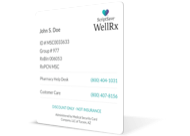Copyright 2024
Medical Security Card Company, LLC
All Rights Reserved
WellRx will never sell your personal information. Period. By signing up I agree to WellRx's terms of use and privacy policy.
By Jacquelyn Buffo, MS, LPC, CAADC
October 12, 2021
When you think of seasonal affective disorder (SAD), you probably think of low mood and symptoms of depression that occur during the cold winter months. Symptoms usually begin in the fall months and last throughout the winter. Millions of people across the country are diagnosed with SAD. More specifically, research shows that 10 million people in the United States experience this condition.
If you experience symptoms of SAD, you can take steps to manage those symptoms, and help is available.
Many people notice a change in mood during the cold winter months. Reduced sunshine, hours of daylight, and bitter cold can impact our mood and mental health. If you experience significant changes in mood and behavior during the late fall and winter months, you may be experiencing SAD.
SAD is not considered a distinct form of depression; instead, it’s a subset of major depression. Symptoms include those of major depression and last for 4-5 months. They include:
It’s important to note that you don’t need to experience all these symptoms to meet SAD or major depression criteria. It is vital to assess your functioning. If you’re experiencing any of these symptoms and having difficulty performing tasks of daily living (showering, going to work, taking care of your children), you may have SAD.
Seasonal affective disorder can impact individuals who do not have any other mental health issues and people diagnosed with major depression and other mental health and mood disorders. More specifically:
There is no one known cause for the development of SAD, but many factors can contribute to SAD. Studies show that risk factors include:
If you experience any of the symptoms listed above, you may benefit from treatment. Luckily, there are many ways to treat SAD’s symptoms effectively. What works for you may be different than what works for other people. Here are some common treatments that your provider may use.
Scientists believe that light therapy works by introducing artificial “sun rays” to your body, resetting your biological clock.
There are two different types of light therapy, including bright light treatment and dawn simulation. With bright light treatment, you place the light near you on a desk or workstation and turn it on while working throughout your day. With dawn simulation, a dim light activates in the morning and gradually gets brighter throughout the morning; this emulates a sunrise.
If you’re interested in incorporating light therapy into your routine, talk to your doctor to see if it’s right for you.
If you think you may be experiencing symptoms of SAD or any other mood and mental health disorder, consult with your doctor about what you are experiencing. They may be able to prescribe an anti-depressant or mood stabilizer to help manage and reduce your symptoms. If you need help paying for your medication, ScriptSave® WellRx can help you save more on your next pharmacy visit.
Evidence-based therapeutic interventions can help reduce and manage symptoms of SAD. Cognitive-behavioral therapy is one of those methods. A licensed mental health professional can also provide behavioral strategies to help you mitigate and reduce your vulnerability to symptoms of SAD.
Other behavioral and lifestyle strategies such as engaging in fun and enjoyable activities, staying hydrated, getting plenty of rest, eating healthy foods, and exercising can improve your mood and combat symptoms of depression.
If you think you or someone you know is struggling with SAD, help is available. You do not have to live with the negative impact of SAD or any other mental health disorder. Talk to your doctor about treatment options available to you.
Jacquelyn Buffo is a licensed professional counselor with experience and expertise in substance abuse and mental health issues. She received her MS in mental health counseling from Capella University and is a Certified Advanced Alcohol and Drug Counselor through the state of Michigan. She is also in the process of receiving her certification in dialectical behavior therapy (DBT). Jacquelyn has experience working with clients suffering from addiction and mental health issues on an in-home, residential, and outpatient basis. Currently, she works with adolescents and adults with Borderline Personality Disorder, Major Depressive Disorder, PTSD and Generalized Anxiety Disorder through Henry Ford Health System.
Resources:
https://www.bu.edu/articles/2019/seasonal-affective-disorder/
https://www.nimh.nih.gov/health/publications/seasonal-affective-disorder
https://medlineplus.gov/genetics/condition/seasonal-affective-disorder/#frequency

For your convenience, use the ScriptSave® WellRx mobile app. Now savings are well in hand, right at the pharmacy counter. Save on your family's prescription medicines.
Learn More
Your choice. Get a ScriptSave WellRx Savings Card. Or Download the free mobile app from the App Store or Google Play Store
Get A Card
ScriptSave WellRx Grocery Guidance leverages leading-edge nutritional data science to help you know which food products on your grocery store shelf are truly good for YOU.
Healthy Foods For YouTags:

November 07, 2024

October 23, 2024

May 07, 2024
You need to log into the site to use this feature
This feature requires registration. Sign up or log in to your free WellRx account to gain access to this and other tools to help make managing your medications and wellness easier.
Benefits Include:
 Store & manage your medication list
Store & manage your medication list
 Medication pricing updates
Medication pricing updates
 Medication information
Medication information
 Pill & refill reminders
Pill & refill reminders
 Medication journal & mood log
Medication journal & mood log
This feature requires registration. Sign up or log in to your free WellRx account to gain access to this and other tools to help make managing your medications and wellness easier.
Benefits Include:
 Store & manage your medication list
Store & manage your medication list
 Medication pricing updates
Medication pricing updates
 Medication information
Medication information
 Pill & refill reminders
Pill & refill reminders
 Medication journal & mood log
Medication journal & mood log
You will be redirected to your program in 5 seconds.
Our Terms and Conditions and Privacy Policy have recently been updated.
By declining you will be logged out of your account